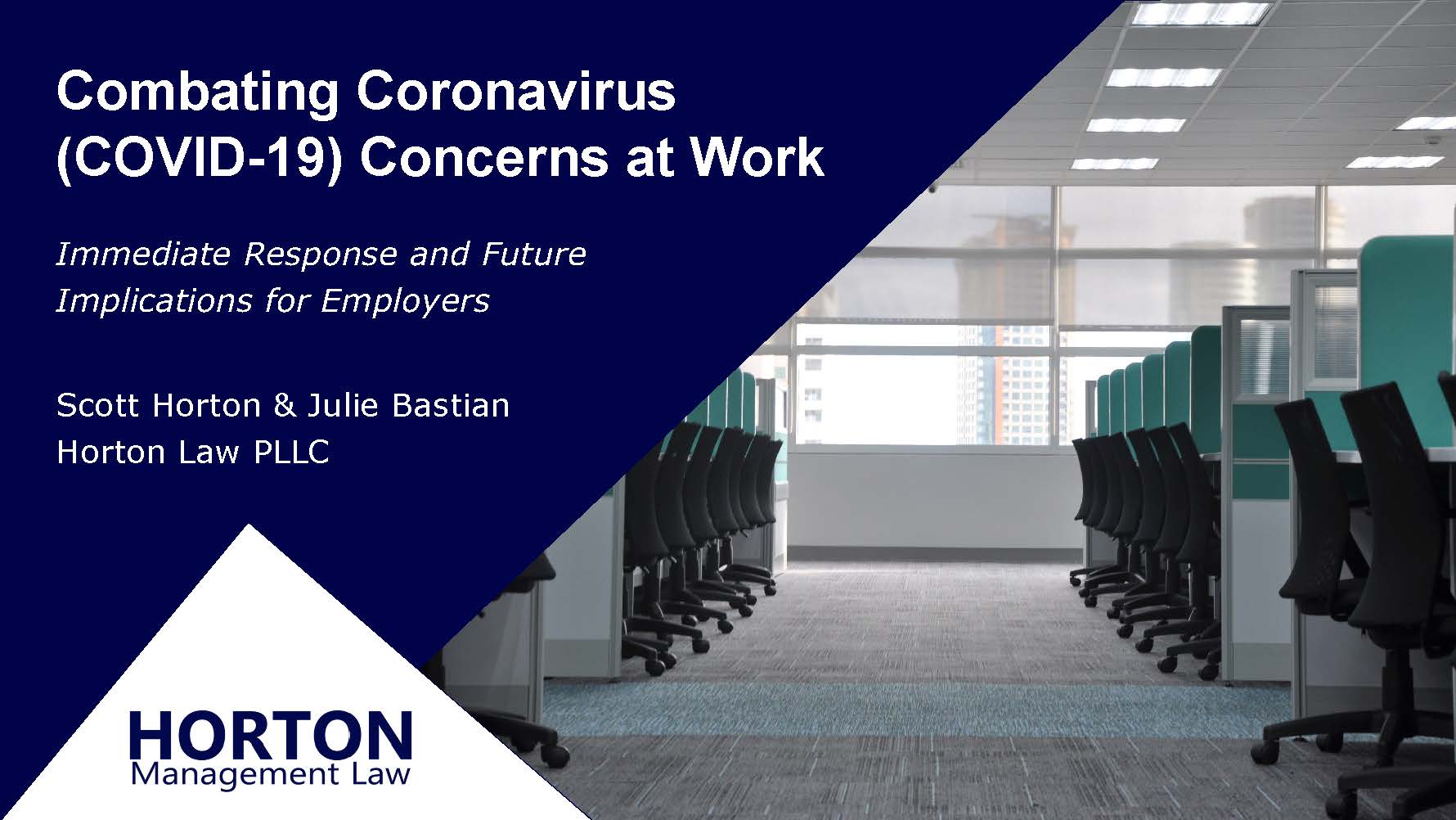On April 1, 2020, the U.S. Department of Labor put out “temporary regulations” interpreting two federal employee leave laws that took effect on that date. Both laws are part of the Families First Coronavirus Recovery Act (FFCRA). The Emergency Paid Sick Leave Act grants many employees up to two weeks of paid leave related to COVID-19. The Emergency Family and Medical Leave Expansion Act allows FMLA leave, with partial pay, to care for a child whose school closed due to the coronavirus crisis. Despite the “temporary label,” it does not appear the DOL intends to issue “permanent” COVID-19 leave regulations. These rules are effective immediately and will remain in effect only until December 31, 2020, when these leave laws expire.
The hastily drafted emergency legislation has created unfortunate complexity in applying these new COVID-19 leave laws. Through its temporary regulations, the U.S. DOL repeatedly emphasizes the goal of interpreting the two separate leave laws “to ensure consistency”. To do this, the DOL has, in some cases, literally ignored the actual words Congress used in the laws themselves. It has also “relaxed” some existing FLSA regulations that might otherwise seem to guide the application of these new laws.
For the basic requirements of these laws, read Congress: Some Employers Must Give Paid COVID-19 Leave.
Covered Employers
The laws generally apply to private companies with under 500 employees working in the United States and all government entities.
How Many Employees Do We Have?
The temporary COVID-19 leave regulations provide some explanation of how to count employees to determine coverage.
Companies should look at their employee count as of the date any employee would begin paid sick leave or expanded FMLA leave under the FFCRA. Accordingly, coverage can change from day to day. For example, businesses that lay off employees for economic reasons during the coronavirus crisis could fall below 500 employees, and then remaining employees would become eligible to take these leaves. Indeed, the regulations explain that employees on furlough or temporary layoff do not count in determining coverage.
On the other hand, employees on “any kind of leave” do count toward the 500-employee threshold. Unfortunately, the regulations don’t further distinguish “leave” from “furlough”. Most likely, any employee being paid is on leave and counts. But what about employees receiving severance or other separation pay? Or employees on unpaid leave as a disability accommodation?
The DOL relies on existing regulatory guidance under the FLSA and FMLA to evaluate whether separate entities are “joint employers” or could constitute an “integrated employer.”
Small Business Exemption
Companies with fewer than 50 employees can elect an exemption from the FFCRA leave requirements by concluding that one or more of the following conditions applies:
- the leave requested would result in the small business’s expenses and financial obligations exceeding available business revenues and cause the small business to cease operating at a minimal capacity;
- the absence of the employee requesting leave would entail a substantial risk to the financial health or operational capabilities of the business because of their specialized skills, knowledge of the business, or responsibilities; or
- there are not sufficient workers who are able, willing, and qualified, and who will be available at the time and place needed, to perform the labor or services provided by the employee requested leave, and these labor or services are needed for the small business to operate at a minimal capacity.
Employers who adopt this exemption can only deny leave to otherwise eligible employees whose leave would specifically contribute to the corresponding condition above. The small employer must specifically document the denial of leave for each employee who requests it.
Exempt Employees
Otherwise-covered employers may choose not to provide leave under the FFCRA to health care providers or emergency responders. The COVID-19 leave regulations interpret these exemptions broadly, but the DOL encourages employers to allow such employees leave as “judiciously” as possible.
Health Care Providers
The DOL defines health care provider for this purpose as “anyone employed at”:
- any doctor’s office,
- hospital,
- health care center,
- clinic,
- post-secondary institution offering health care instruction,
- medical school,
- local health department or agency,
- nursing facility,
- retirement facility,
- nursing home,
- home health care provider,
- any facility that performs laboratory or medical testing, or
- any similar institution, employer, or entity.
The exemption applies to any permanent or temporary site “where medical services are provided that are similar to such institutions.”
It also includes:
- any individual employed by an entity that contracts with any of these institutions described above to provide services or to maintain the operation of the facility where that individual’s services;
- anyone employed by an entity that provides medical services, produces medical products, or is otherwise involved in the making of COVID-19 related medical equipment, tests, drugs, vaccines, diagnostic vehicles, or treatments; and
- any individual that the highest official of a State or territory, including D.C., determines is a health care provider necessary for that State or territory’s response to COVID-19.
Emergency Responders
The DOL intentionally interpreted “emergency responder” broadly “to complement–and not detract from–the work being done on the front lines to treat COVID-19 patients, prevent the spread of COVID-19, and simultaneously keep Americans safe and with access to essential services.”
Based on various existing regulatory definitions, “emergency responders” include employees who are “necessary for the provision of transport, care, healthcare, comfort and nutrition of such patients, or others needed for the response to COVID-19.”
The COVID-19 leave regulations specify that this includes (but is not necessarily limited to):
- military or national guard,
- law enforcement officers,
- correctional institution personnel,
- firefighters,
- emergency medical services personnel,
- physicians,
- nurses,
- public health personnel,
- emergency medical technicians,
- paramedics,
- emergency management personnel,
- 911 operators,
- child welfare workers and service providers,
- public works personnel; and
- persons with skills or training in operating specialized equipment or other skills needed to provide aid in a declared emergency.
It also includes:
- individuals who work for such facilities employing these individuals and whose work is necessary to maintain the operation of the facility; and
- any individual that the highest official of a State or territory, including D.C., determines is an emergency responder necessary for that State or territory’s response to COVID-19.
Additional Clarifications
If an employer chooses not to treat an employee as exempt, then the employee is subject to all the other leave parameters. That includes the employer’s ability to receive a corresponding tax credit.
The regulations emphasize that the law only gives individuals a right to two weeks of leave under the Emergency Paid Sick Leave Act. This is a per-employee entitlement, not a per-employer one. Thus, an employee who has used two weeks of paid sick leave for one employer can’t take it again for another job, such as with a subsequent employer. However, the regulations don’t explain how separate employers would effectively monitor that scenario.
School Closings
Both paid sick leave and expanded FMLA may be available to employees whose children are home due to school closing or child care unavailability. However, the DOL recognizes limits on this leave condition.
To qualify on this basis, the employee must actually care for the child(ren) while off of work. Moreover, the employee would not be eligible if another suitable individual is available to care for the child(ren).
The DOL interprets the FFCRA to allow such leave, where applicable, to care not only for children under 18 years old. Employees could also take the leave to care for children older than 18 who are incapable of self-care because of a mental disability. The adult child’s school or usual place of care would still have to be unavailable due to COVID-19.
Amount of Leave and Compensation
The DOL acknowledges ambiguity in the use of mixed references to days and weeks in these leave laws. Generally, its COVID-19 leave regulations interpret references to 10 days to mean two weeks. Congress apparently used 10 days on the simple assumption of full-time employees working 5 days per week. But the DOL recognizes that many other work schedules exist. Thus, specifically, the unpaid portion of expanded FMLA runs for two weeks rather than just 10 workdays.
The regulations also seek to simplify the calculation of the normal hours worked and “regular rate” for determining how much pay employees receive while on these leaves. Typically, employers should look to the past 6 months before leave to calculate these. However, for employees who have worked less than 6 months, the FFCRA states that employers should use the employee’s “reasonable expectation” at the time of hiring of the number of hours they would receive per week to determine the number of hours a part-time employee receives in leave. The DOL interprets this to mean either an express agreement between the employer and employee or, if none, the average number of hours the employee has worked per week since the beginning of employment.
Once the employer determines which weeks to use in calculating the employee’s regular rate of pay, they must take the weighted average of compensation for those weeks. You do this by dividing the total compensation for the time period by the total number of hours worked during the period.
Remember that no employee is eligible to receive more than $511 per day for sick leave due to the employee’s medical condition or more than $200 per day for other qualifying circumstances under the FFCRA.
Quarantine or Isolation Orders
The DOL takes a broad view of quarantine or isolation orders in determining who may take paid sick leave. The regulations interpret this to include “quarantine, isolation, containment, shelter-in-place, or stay-at-home orders issued by any Federal, State, or local government authority that cause the Employee to be unable to work even though his or her Employer has work that the Employee could perform but for the order.”
Generally, an employee under such an order could not take the leave if they are still able to work, either onsite or remotely. However, if a governmental authority has advised individuals in specific categories (e.g., certain age ranges or medical conditions) not to go into work, then an employee in such a category who cannot work from home would qualify for leave.
The DOL also clarifies that employees cannot take paid sick leave if the employer does not have work for the employee. Thus, if the quarantine or isolation order causes the employer to cease operations, even temporarily, the employee cannot take leave, but may instead be able to apply for unemployment benefits.
Teleworking
Employees who can telework are not entitled to paid sick leave or expanded FMLA leave under the FFCRA.
The regulations define “telework” to mean “work the Employer permits or allows an Employee to perform while the Employee is at home or at a location other than the Employee’s normal workplace.”
An employee is able to telework if:
- their employer has work for them;
- their employer permits the employee to work from the employee’s location; AND
- there are no extenuating circumstances (such as serious COVID-10 symptoms) that prevent the employee from performing the available work.
The DOL notes that existing FLSA regulations include “continuous workday” guidelines with respect to paying minimum wage and overtime. Typically, the DOL would consider all time between the performance of the first and last principal activities in a day to be time worked. However, the agency expressly relaxes that requirement for employees working sporadic at-home schedules for COVID-19 related reasons.
Intermittent Leave
The temporary COVID-19 leave regulations declare that intermittent leave is only available under FFCRA if both the employee and employer agree to it. They must also agree to the time increments for any intermittent leave.
Moreover, unless the employee is teleworking, intermittent leave is only permissible when the employee is using it to care for a child whose school is closed or care provider is unavailable. The DOL expresses concern that allowing intermittent leave for other circumstances under the paid sick leave law would pose too much of a risk of spreading COVID-19 to other employees.
Overall FMLA Leave
The regulations confirm that expanded FMLA leave due to children being home because of COVID-19 is still subject to the annual total of 12 weeks of FMLA leave for any purpose (except military servicemember caregiver leave, which may allow additional unpaid leave). Thus, an employee who has already used any FMLA leave within the applicable 12-month period set by the employer will not get a full 12 weeks of COVID-19 FMLA leave. Conversely, an employee who uses COVID-19 FMLA leave will have less leave, if any, available for the traditional FMLA circumstances.
The regulations also indicate that an employee may only take a maximum of 12 weeks of FMLA leave because of their child’s school closing or child care being unavailable. This clarification could be important, as an employer’s standard 12-month FMLA leave period could start over during 2020. Then, an employee might be able to take additional FMLA for other qualifying reasons, but no more than 12 weeks of the new leave under the FFCRA between April 1 and December 31, 2020.
Notices
Employee Rights Poster
The FFCRA requires employers to post an employee rights notice in conspicuous places in the workplace. The regulations allow that employers can meet this requirement by posting the notice electronically on an employee information website or by emailing it to them. However, the regulations do not specify that employers must do so even where employees can’t currently access the worksite.
The regulations specify that even a small company that finds it is exempt from providing leave must satisfy this posting requirement.
FMLA Forms
The DOL is not requiring employers to satisfy the regular FMLA notification requirements regarding the expanded FMLA leave under FFCRA. Employers accustomed to providing the FMLA paperwork, including notices of eligibility, rights and responsibilities, and written designations, may continue to do so for this new form of leave. But they do not have to (unless an employee may also qualify for another type of FMLA leave).
Employee Notice of Need for Leave
Employees do not have to notify their employer before beginning leave under the FFCRA. Employers can require employees to follow reasonable notice procedures as soon as practicable after the first workday for which an employee needs paid sick leave. They can also require employees to comply with usual notice procedures and requirements. However, the regulations add that if the employee fails to give proper notice, the employer should notify the employee of failure and give them a chance to provide the appropriate documentation before denying the leave.
Documentation Supporting Leave Requests
Because employers will need documentation to support the FFCRA tax credits, employees must provide a signed statement containing the following information:
- employee’s name;
- date(s) for which leave is requested;
- the COVID-19 qualifying reason for leave; and
- a statement representing that the employee is unable to work or telework because of the COVID-19 qualifying reason.
The employee must also provide additional documentation corresponding to the nature of the qualifying reason. As applicable, this documentation could include the identity of the government entity or healthcare provider ordering a quarantine or the name of the child and their school that is closed. In the latter situation, the employee also must provide a statement that no other suitable person is available to care for the child during the requested leave.
Leave Before April 1, 2020
Employers cannot deduct time employees took off before April 1, 2020, from these new federal leave requirements. Nor can employees be required to use other employer-provided leave simultaneously with these leaves.
The DOL recognizes that some employers proactively put new leave policies in place before April 1, 2020, to help employees through this coronavirus emergency. The COVID-19 leave regulations permit these employers now to cancel such policies prospectively in light of the new federal requirements.
Leave After December 31, 2020
The temporary COVID-19 leave regulations confirm that no employee has a right to leave under the FFCRA after December 31, 2020. An ongoing leave that began before then will automatically end on that date.
Administration Costs
DOL estimates covered employers will spend over $550,000,000 familiarizing themselves with and preparing to apply these leaves to employees. Based on the assumptions the Department of Labor used in their calculations, the actual costs will probably be much higher. And this doesn’t even factor in the additional time and expense of processing leave requests from employees or lost productivity due to their absences.
Navigating the COVID-19 Leave Regulations
Many small businesses that are not already subject to the FMLA may find it particularly difficult to apply these new requirements. The law and regulations are complex and not necessarily intuitive. Even determining whether your company must comply could be a challenge.
Some questions and issues will seem to be straightforward, but may involve an unexpected wrinkle. And, unfortunately, there are significant built-in penalties for making mistakes in either direction–either granting leave too generously or denying it improperly. On the one hand, violating employees’ new rights could result in litigation or administrative fines. On the other hand, paid leave not covered by the law won’t earn a tax credit. Or, if one is taken, it may constitute a violation of tax laws.
Thus, it is critical to thoroughly understand the law and regulations, including corresponding tax provisions. Most employers should work with experienced employment lawyers and tax professionals to determine what they must do to apply these federal leave laws correctly and avoid costly penalties.
For regular updates on COVID-19 issues affecting employers and other employment law developments, follow HortonLaw on LinkedIn.


